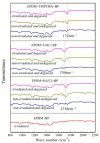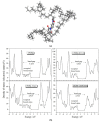Significantly Improved Electrical Properties of Photo-Initiated Auxiliary Crosslinking EPDM Used for Cable Termination
- PMID: 31847065
- PMCID: PMC6961004
- DOI: 10.3390/polym11122083
Significantly Improved Electrical Properties of Photo-Initiated Auxiliary Crosslinking EPDM Used for Cable Termination
Abstract
In order to achieve high quality electrical materials for cable terminations, the crosslinked ethylene-propylene-diene monomer (EPDM) materials, with adequate breakdown strength, appropriately increased conductivity and are developed by employing auxiliary crosslinker and ultraviolet (UV) photoinitiated crosslinking technique. The characteristic cyclic anhydrides with coupled carbonyl groups are utilized as auxiliary crosslinkers to promote crosslinking efficiency and provide polar-groups to EPDM molecules in UV-initiated crosslinking processes, which can be effectively fulfilled in industrial cable production. The results of infrared spectroscopy show that the auxiliary crosslinkers have been successfully grated to EPDM molecules through UV initiation process. The conductivity of EPDM increases after individually utilizing three auxiliary crosslinkers to EPDM at various temperatures of cable operations, by which the highest conductivity has been acquired by grafting N.N-m-phenylene dimaleimide. The first-principles calculations demonstrate that some occupied local electronic-states have been introduced in the band-gap of the EPDM crosslinked by N.N-m-phenylene dimaleimide (EPDM-HAV2), which can be thermally excited from valence band to conduction band at lower temperature or in higher density, leading to augmentation in electrical conductivity. Meanwhile, the breakdown strength achieves a significant improvement in consistency with the theoretical estimation that deeper hole-traps can be introduced by auxiliary-crosslinking modification, and will consequently increase breakdown strength through the trapping mechanism of space charge suppression. in relation to the appropriately increased conductivity, in combination with persistent breakdown strength, the finite element simulations of the electric field distribution in EPDM cable terminations suggest that the effectively homogenized electric field at the root of stress cone will be realized for EPDM-HAV2. The present study offers a fundamental strategy to ameliorate EPDM materials in the application of insulated cable accessories.
Keywords: crosslinking reaction; electrical conductance; finite element simulation; first-principles calculation; ultraviolet irradiation.
Conflict of interest statement
The authors declare no conflict of interest.
Figures





References
-
- Eichhorn R.M. A critical comparison of XLPE-and EPR for use as electrical insulation on underground power cables. IEEE Trans. Electr. Insul. 1981;16:469–482. doi: 10.1109/TEI.1981.298377. - DOI
-
- Roberto A., Gennaro G., Maurizio A., Cosimo C., Maria E.E. Polymer–filler interactions in PET/CaCO3 nanocomposites: Chain ordering at the interface and physical properties. Euro. Polym. J. 2013;49:419–427.
-
- Lan L., Wu J.D., Wang Y.N., Yin Y. Space charge property at the interface in low density polyethylene/ethylene propylene rubber double-layered insulation. Proc. CSEE. 2015;35:1266–1272.
-
- Hanley T.L., Burford R.P., Fleming R.J. A general review of polymeric insulation for use in HVDC cables. IEEE Electr. Insul. Maga. 2003;19:13–24. doi: 10.1109/MEI.2003.1178104. - DOI
-
- Rogti F., Mekhaldi A., Laurent C. Space charge behavior at physical interfaces in cross-linked polyethylene under DC field. IEEE Trans. Electr. Insul. 2008;15:1478–1485. doi: 10.1109/TDEI.2008.4656259. - DOI
Grants and funding
LinkOut - more resources
Full Text Sources
Miscellaneous

